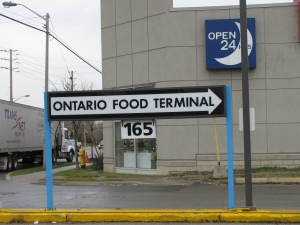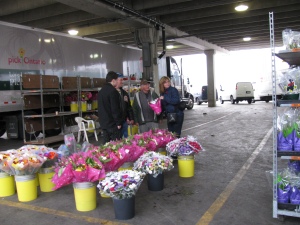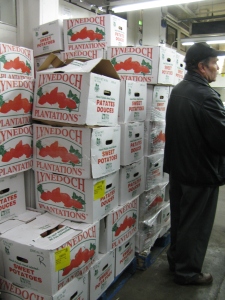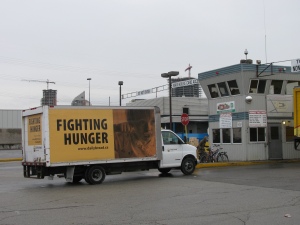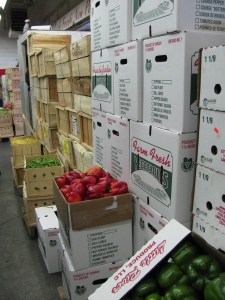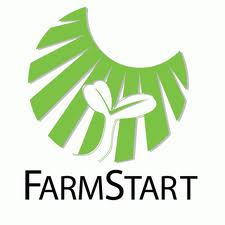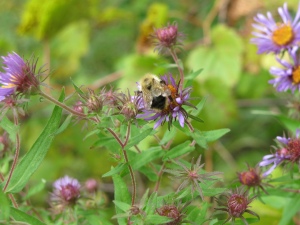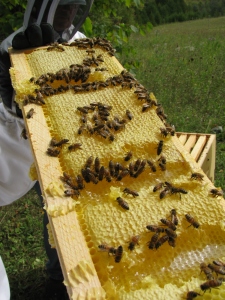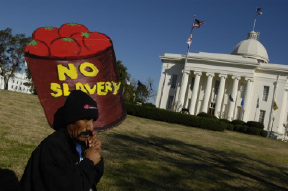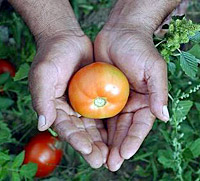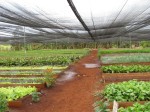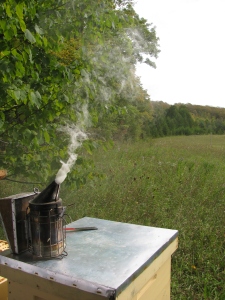
keepin' bees
In my September 23rd post I discussed the Honeybee tour I attended in Grey County, and some beekeeping and farming organizations in the area. Today I’m going to share a bit of what I learned on the tour, things about bee colonies, honey extraction, and beekeeping basics. It’s fascinating stuff – read on!
Bee Basics
Honeybees live in colonies made up of three types of bees: workers, drones, and the queen. The most common type of bee is workers, who are all female, and take care of everything necessary to keep the hive going, collecting pollen, making honey, cleaning, feeding, defense – everything!

Drone Cells (centre)
Second most common, drones are slightly larger, and come from specialized drone cells. They are male, and basically laze around the hive all day eating honey until at one point they mate with the queen and die. Those who don’t get the chance to mate get thrown out of the hive when winter comes to save resources and are left for dead. There is only one Queen, and she is selected as a larva and fed royal jelly so that she becomes extra large. When she mates with the drones she stores sperm inside her body, allowing her to produce new bees for the next 2-7 years. To survive the winter, the bees huddle around the Queen, moving their wings to create warmth. They eat up their honey stores to stay alive through the winter, though in large-scale beekeeping facilities the majority of the honey is harvested and the bees are fed sugar water. Whether or not this is good practice is open to debate, some argue it’s healthier as it causes less waste buildup over the winter, while others say it’s not natural.
Honey Production

Honey Varieties
Honey is made from pollen that bees harvest, partially digest and store in cells. The bees fan their wings over the cells, causing water to evaporate from the nectar, until the point where it turns to honey. Then they cap the cells with wax, allowing the honey to store without fermenting. Because bees only travel within 3-5 km of their hives to gather pollen, it is possible to produce different varieties of honey depending what plants are in the region. Honey from different flowers have different colours and flavours, for example blueberry honey being light and thin, orange honey (my favourite!) medium colour and extra flavourful, and chestnut honey being dark, thick, and very strong-flavoured. The average honey you buy in the grocery store is wildflower honey, meaning the bees have foraged from a variety of sources.
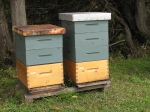
Yellow Brood Boxes and green Honey Supers
In order to ensure that the hive is creating surplus honey for harvesting, beekeepers provide a brood box on the bottom for laying eggs and a honey super on top for storing honey. A Queen Separator is included between the two to ensure that the Queen cannot get through and lay eggs in the super. Some colonies are more productive than others, so when the first super is 3/4 full, another may be added.
Honey Extraction

Smoking the hive
When extracting, you want to consider the mood of the bees. If the hive has recently been attacked or weather has been bad, there’s a good chance they’ll be agitated, but generally a hive with a good queen will be docile. Light the smoker with wood shavings or pine needles, and approach the hive from the side so you don’t enter the bee’s flight path. A hive tool is used to crack the top cover open, it will usually be sealed with wax and propolis. You can begin to smoke the hive,

Hive Tool
which signals to the bees that they should start eating honey rather than stinging you. If the honey cells are capped they are ready for harvesting, and can be brushed free of bees and taken for extraction. It’s important to extract at a good distance from the hive,

Robbed Honeycomb
because bees rob honey – they will try to steal it back from you by eating it! (take a look at this picture of comb left near the hive – this is a great way to clean off honey extraction tools with little effort). Moving farther away means less bees will follow you and less honey can be robbed.

Commercial Comb Cutting
The first step in extraction is removing the caps from the honey, either with a sharp tool or with heated blades, as in the commercial system. The room must be kept at at least 30 degrees C for honey to be extracted, though it shouldn’t spill out of the uncapped comb as the cells are sloped at a 15 degree angle which keeps the honey inside. The comb is then put in a centrifuge, forcing the honey to spin out and collect at the bottom, to be released by a spigot, or pumped elsewhere in larger operations.
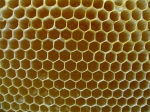
Look at that 15 degree angle!
Honey can then be directly bottled, innoculated with “seed” crystals to form creamed honey, or pasteurized, an unnecessary step that gives honey a longer shelf life without crystallizing, but removes some health benefits. Unpasteurized honey can be reliquified by placing the jar in boiling water for a few minutes. An interesting fact I learned from Catherine at Chatsworth Honey was that honey from different sources crystallizes at different rates; canola honey can crystallize in the comb, whereas honey from fireweed won’t crystallize for five years!
I was going to go into bee diseases and hive problems in this post, but I’ll save it for another day, this post is long enough! Please feel free to email or post with any bee-related questions, and I’ll do my best to answer them!
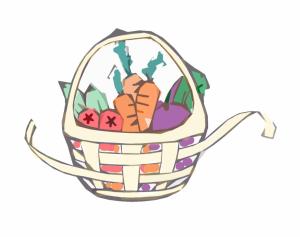 Great food security conference happening this weekend in Montreal! Hosted by Food Secure Canada, this conference will be discussing the wide range of ways to make Canada more food secure, with a variety of talks and workshops under the theme “Weaving together food policy and community action: an agenda for change”. The conference will look for contributions to the development of Canada’s Food Security Policy and discuss issues such as the impact of biofuels on food security and tecchniques to connect food movements at provincial and local levels.
Great food security conference happening this weekend in Montreal! Hosted by Food Secure Canada, this conference will be discussing the wide range of ways to make Canada more food secure, with a variety of talks and workshops under the theme “Weaving together food policy and community action: an agenda for change”. The conference will look for contributions to the development of Canada’s Food Security Policy and discuss issues such as the impact of biofuels on food security and tecchniques to connect food movements at provincial and local levels.
